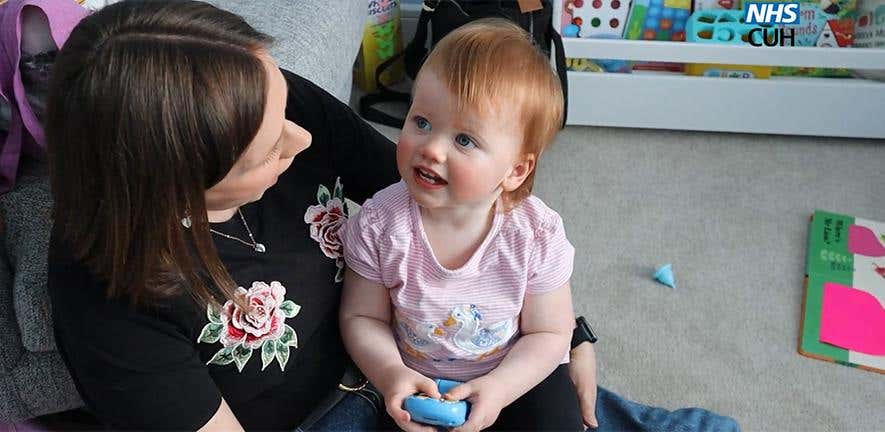Toddler born deaf hears for the first time after groundbreaking gene therapy
A toddler born profoundly deaf can now hear naturally thanks to a groundbreaking gene therapy that rewrote her hearing genes.

A 3-year-old born deaf now hears naturally after a world-first gene therapy restores her hearing. (CREDIT: Jo and James Sandy)
When she was born, doctors informed Opal Sandy's parents that their child would never hear. At the age of 11 months, she had not reacted even to the most noise. Two years later, the same child now dances to music and responds when she is called—in all due to a single gene therapy injection that changed her life.
3-year-old Opal was the world's youngest patient to receive a hearing-restoring gene therapy in 2023. The medicine treated a rare inherited mutation in the OTOF gene that prevents the inner ear from communicating sound signals to the brain. Her case has since been a milestone in modern medicine—proof that it is possible for a child born with profound deafness to gain natural hearing.
A Breakthrough Moment in Medicine
The 15-minute procedure was performed in the United Kingdom, where Opal's family lives. Under general anesthesia, doctors inserted a healthy copy of the flawed OTOF gene into her right cochlea, the spiral-shaped inner ear structure that converts sound vibrations into electrical signals for the brain. During the same operation, a cochlear implant was implanted in her left ear as a backup.
The new treatment, named DB-OTO, was developed by Regeneron Pharmaceuticals, a biotech company based in New York. It uses a virus that is engineered to deliver functional genetic instructions directly into the sensory cells of the ear. The approach is meant to restore the cells' ability to make a key protein that is needed for hearing.
Her parents, Jo and Paul Sandy, were cautiously hopeful at first. Weeks following the surgery, doctors noticed something remarkable. Opal began to respond to sounds. Soon she was turning her head toward voices, laughing at music, and responding when her name was called.
Opal's able to hear perfectly with her right ear alone now, even when the implant in her left ear is turned off. According to Jo and Paul, "The difference has been mind-blowing."
How the Therapy Works
In healthy ears, sound waves travel through the ear canal and make the eardrum vibrate. Those vibrations travel to the cochlea, where extremely tiny hair cells convert them into nerve signals. In children with OTOF mutations, the protein that allows for the conversion does not exist, so the auditory nerve is silent.
DB-OTO works by introducing a functional copy of the gene directly into the cells of the cochlea. Once the new gene takes effect, the cells can once again transform sound into electrical signals and pass them along to the brain. The treatment is designed to be long-term, restoring hearing at the genetic level rather than utilizing external devices.
For precision, doctors must deliver the viral vector exactly where it's needed without damaging any surrounding tissue. They also monitor closely for immune responses and titrate dose to avoid overcorrection. No adverse effects have been reported as yet in the ongoing clinical trials.
Early Results Bring Hope
Regeneron announced in October 2025 that 11 of the first 12 children who had been given DB-OTO had seen significant improvement in hearing within weeks of getting the injection. Many, Opal among them, just keep improving over time. The trial has since opened to patients in the United States, Spain, Germany, and the U.K., and is recruiting children under 18 years old.
Opal's case is stunning not only for her rapid progress but for what it reveals about the brain's capacity for recovery. Scientists had wondered for years whether restoring hearing in babies after early deafness would hold, since the brain's auditory pathways depend on stimulation in order to develop normally. Her success shows those pathways can adapt when given proper input—even after months of silence.
Experts believe this approach could eventually replace or reduce the need for hearing aids and cochlear implants for certain genetic types of deafness. “It’s an extraordinary step forward,” said a member of the clinical research team. “For the first time, we’re not just compensating for hearing loss—we’re correcting the underlying cause.”
Challenges and Ethical Hurdles
Despite the enthusiasm, scientists are cautious. Gene therapy is a new field, and there is minimal margin for error in the inner ear's intricacy. Long-term data will be required to see whether the improvement holds and whether side effects with delayed onset could occur.
Cost and access are also major issues. Producing safe viral vectors and organizing worldwide clinical trials are costly. Even if the therapy is approved, its cost may restrict availability unless governments or insurers get involved.
There are also moral questions of how early in life such therapies should be given. Timing is everything—early enough for brain development, but only after safety has been fully assured. Transparency, informed consent, and fair access will be essential as the technology progresses.
From Silence to Sound
For Opal's family, however, the change has already transformed daily life. Where there was silence, there are now gurgles, songs, and bedtime stories. Jo Sandy describes the moment she knew her daughter could hear, saying: "It was like the world had opened up for her. She turned her head towards my voice and smiled."
Her older sister, who still uses hearing aids, now plays and speaks with her in ways never before possible. The therapy hasn't just restored sound—it's recreated family connection.
Previous OTOF Gene Therapy Milestone
As previously reported by The Brighter Side of News in July, a groundbreaking clinical trial in China successfully restored hearing in patients born with a rare genetic form of deafness, marking a major step forward in gene therapy. The treatment targets mutations in the OTOF gene, which is responsible for producing otoferlin — a protein that helps transmit sound from the ear to the brain. When this gene is faulty, children are born with profound hearing loss, but researchers have now shown that replacing it with a healthy version can reverse deafness.
The trial, conducted across five hospitals in China, used a single injection of an engineered virus to deliver the healthy OTOF gene directly to the base of the cochlea — the inner-ear structure vital for hearing. The therapy, which had already been proven safe in animal studies, was given to ten patients ranging from toddlers to young adults. Over a period of six to twelve months, participants showed significant hearing improvement, with no serious side effects reported. The most common temporary issue was a mild decrease in white blood cells.
Results were especially striking among younger children. Those aged five to eight saw the greatest recovery, with one seven-year-old regaining near-normal hearing within just four months. On average, hearing levels improved from around 106 decibels — classified as profound deafness — to about 52 decibels, enough to detect normal conversation. While older patients experienced smaller gains, all participants benefited from the therapy.
Researchers continue to track the patients to see how long the improvements last, while also expanding their work to other genetic forms of deafness caused by mutations in genes such as GJB2 and TMC1. The success of this trial could open the door to a new era of hearing restoration therapies, offering hope to families affected by hereditary hearing loss around the world.
Practical Implications of the Research
This breakthrough marks a turning point for the treatment of inherited deafness. By proving that gene therapy can safely restore hearing in a living child, scientists have opened doors for similar treatments targeting other genetic conditions affecting the eyes, muscles, and brain.
For millions worldwide living with hereditary hearing loss, this technology offers the possibility of a cure rather than lifelong assistive devices. It could also inspire new policies supporting early genetic testing and intervention, giving children the best chance for natural hearing development.
In the long run, therapies like DB-OTO could redefine how society views deafness—from an unchangeable condition to one that science can meaningfully address.
Related Stories
- Researchers discover genetic cause of hearing loss and identify possible treatments
- Gene therapy restores hearing in deaf children and adults
- Finger-tapping trick can sharpen your hearing against background noise
Like these kind of feel good stories? Get The Brighter Side of News' newsletter.
Joseph Shavit
Science News Writer, Editor-At-Large and Publisher
Joseph Shavit, based in Los Angeles, is a seasoned science journalist, editor and co-founder of The Brighter Side of News, where he transforms complex discoveries into clear, engaging stories for general readers. With experience at major media groups like Times Mirror and Tribune, he writes with both authority and curiosity. His work spans astronomy, physics, quantum mechanics, climate change, artificial intelligence, health, and medicine. Known for linking breakthroughs to real-world markets, he highlights how research transitions into products and industries that shape daily life.



